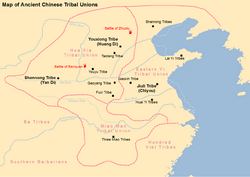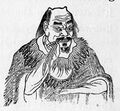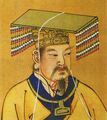Three Sovereigns and Five Emperors
Topic: History
 From HandWiki - Reading time: 5 min
From HandWiki - Reading time: 5 min
Three Sovereigns and Five Emperors 三皇五帝 | |||||||
|---|---|---|---|---|---|---|---|
| c. 2852 BC (traditionally)–c. 2070 BC (start of Xia dynasty) | |||||||
| Capital |
| ||||||
| Government | Monarchy | ||||||
| Emperor | |||||||
• c. 2852 – 2737 BC or c. 2952 – 2836 BC | Fuxi | ||||||
• c. 2495 – 2437 BC | Zhuanxu | ||||||
• c. 2436 – 2366 BC | Ku | ||||||
• c. 2356 – 2255 BC | Yao | ||||||
• c. 2355 – 2241 BC | Shun (last) | ||||||
| History | |||||||
• Established | c. 2852 BC (traditionally) | ||||||
• Disestablished | c. 2070 BC (start of Xia dynasty) | ||||||
| |||||||
| Today part of | China | ||||||
| Three Sovereigns and Five Emperors |
|---|
The Three Sovereigns and Five Emperors (Chinese: 三皇五帝; pinyin: sānhuáng wǔdì) were a group of mythological rulers and sheng (sages) from ancient China .[1][2] Today, they are considered culture heroes,[3][4] but they were widely worshipped as divine "ancestral spirits" in ancient times. According to received history, the period they existed in preceded the Xia dynasty,[5] although they were thought to exist in later periods to an extent[6] in incorporeal forms that aided the Chinese people, especially with the stories of Nüwa existing as a spirit in the Shang dynasty[7] and Shennong being identified as the godly form of Hou Ji and a founder of the Zhou.[8]
In myth, the Three Sovereigns were demigods who used their abilities to help create mankind and impart to them essential skills and knowledge. The Five Emperors were exemplary sages who possessed great moral character, and were from a golden age when "communications between the human order and the divine were central to all life" and where the sages were embodiments of the divine or aided humans in messaging divine forces.[9]
In this period the abdication system was used before Qi of Xia violently seized power and established a hereditary monarchy.[10]
History
Taoist mythos and parables involving shamanistic themes were inspired by Tungus shaman folklore, and the most ancient stories about Fuxi, Nüwa, and Shennong as the Three Sovereigns were also inspired by that mythos.[11]
Variations
Depending on the source, there are many variations of who classifies as the Three Sovereigns or the Five Emperors. There are six to seven known variations.[12] Many of the sources listed below were written from much later dynasties.
The following appear in different groupings of the Three Sovereigns: Fuxi (伏羲), Nüwa (女媧), Shennong (神農), Suiren (燧人), Zhurong (祝融), Gong Gong (共工), Heavenly Sovereign (天皇), Earthly Sovereign (地皇), Tai Sovereign (泰皇), Human Sovereign (人皇), and even the Yellow Emperor (黄帝).[2]
The following appear in different groupings of the Five Emperors: Yellow Emperor (黃帝), Zhuanxu (顓頊), Emperor Ku (嚳), Emperor Yao (堯), Shun (舜), Shaohao (少昊), Taihao (太昊), and Yan Emperor (炎帝).
Three Sovereigns
The Three Sovereigns, sometimes known as the Three August Ones, were said to be god-kings or demigods who used their magical powers, divine powers, or being in harmony with the Tao to improve the lives of their people. Because of their lofty virtue, they lived to a great age and ruled over a period of great peace.
They have elements in common with xian, such as the Human Sovereign's cloud-chariot and their supernatural abilities. Upon his death, the Yellow Emperor was "said to have become" a xian.[13]
The Three Sovereigns are ascribed various identities in different Chinese historical texts. The Yellow Emperor is supposedly the ancestor of the Huaxia people.[14] The Mausoleum of the Yellow Emperor was established in Shaanxi Province to commemorate the ancestry legend.[14]
| According to source | Three Sovereigns |
|---|---|
| Records of the Grand Historian (史記), addition by Sima Zhen | Heavenly Sovereign (天皇), Earthly Sovereign (地皇), Tai Sovereign (泰皇)[12] or Fu Xi (伏羲), Nüwa (女媧), Shennong (神農) |
| Sovereign series (帝王世系) | Fu Xi (伏羲), Shennong (神農), Yellow Emperor (黃帝)[12] |
| The book of Lineages (世本) | Fu Xi (伏羲), Shennong (神農), Yellow Emperor (黃帝)[12] |
| Baihu Tongyi (白虎通義) | (1st variation) Fu Xi (伏羲), Shennong (神農), Zhurong (祝融)[12] (2nd variation) Fu Xi (伏羲), Shennong (神農), Suiren (燧人)[12] |
| Fengsu TongYi (風俗通義) | Fu Xi (伏羲), Nüwa (女媧), Shennong (神農)[12] |
| Yiwen Leiju (藝文類聚) | Heavenly Sovereign (天皇), Earthly Sovereign (地皇); Human Sovereign (人皇)[12] |
| Tongjian Waiji (通鑑外紀) | Fu Xi (伏羲), Shennong (神農), Gong Gong (共工) |
| Chunqiu yundou shu (春秋運斗樞) Chunqiu yuanming bao (春秋元命苞) |
Fu Xi (伏羲), Nüwa (女媧), Shennong (神農) |
| Shangshu dazhuan (尚書大傳) | Fu Xi (伏羲), Shennong (神農), Suiren (燧人) |
| Diwang shiji (帝王世紀) | Fu Xi (伏羲), Shennong (神農), Yellow Emperor (黃帝) |
Five Emperors
The Five Emperors were traditionally thought to have invented "fire, writing and irrigation."[15]
| According to source | Five Emperors |
|---|---|
| Records of the Grand Historian (史記) | Yellow Emperor (黃帝), Zhuanxu (顓頊), Emperor Ku (嚳), Emperor Yao (堯), Shun (舜)[12] |
| Sovereign Series (帝王世紀) | Shaohao (少昊), Zhuanxu (顓頊), Emperor Ku (嚳), Emperor Yao (堯), Shun (舜)[12] |
| I Ching (易經) | Taihao (太昊), Yan Emperor (炎帝), Yellow Emperor (黃帝), Emperor Yao (堯), Shun (舜)[12] |
| Comments of a Recluse, Qianfulun (潛夫論) | Taihao (太昊), Yan Emperor (炎帝), Yellow Emperor (黃帝), Shaohao (少昊), Zhuanxu (顓頊)[16] |
| Zizhi tongjian waiji, (資治通鑒外紀) | Yellow Emperor (黃帝), Shaohao (少昊), Zhuanxu (顓頊), Emperor Ku (嚳), Emperor Yao (堯)[16] |
Family tree of ancient Five Emperors
| (1) Yellow Emperor 黃帝[17] | |||||||||||||||||||||||||||||||||||||||||||||
| (2) Shaohao 少昊 | Changyi 昌意 | ||||||||||||||||||||||||||||||||||||||||||||
| Jiaoji 蟜極 | (3) Zhuanxu 顓頊 | ||||||||||||||||||||||||||||||||||||||||||||
| (4) Ku 嚳 | Qiongchan 窮蟬 | Sb. | |||||||||||||||||||||||||||||||||||||||||||
| (5) Zhi 挚 | (6) Emperor Yao 堯 | Houji 后稷 | Jingkang 敬康 | Sb. | |||||||||||||||||||||||||||||||||||||||||
| Danzhu 丹朱 | Juwang 句望 | Sb. | |||||||||||||||||||||||||||||||||||||||||||
| Qiaoniu 橋牛 | Gun 鯀 | ||||||||||||||||||||||||||||||||||||||||||||
| Gusou 瞽叟 | (8) Yu 禹 | ||||||||||||||||||||||||||||||||||||||||||||
| Ehuang 娥皇 | (7) Shun 舜 | Nuying 女英 | |||||||||||||||||||||||||||||||||||||||||||
| Shangjun 商均 | |||||||||||||||||||||||||||||||||||||||||||||
Creation myth
There is the legend of the Four shi (四氏) who took part in creating the world. The four members are Youchao-shi (有巢氏), Suiren-shi (燧人氏), Fu Xi-shi (伏羲氏), and Shennong-shi (神農氏).[18]
Legacy
These kings are said to have helped introduce the use of fire, taught people how to build houses and invented farming. The Yellow Emperor's wife is credited with the invention of silk culture. The discovery of medicine, the invention of the calendar and Chinese script are also credited to the kings. After their era, Yu the Great founded the Xia dynasty.[5]
Gallery
See also
- List of Neolithic cultures of China
- Emperor of China
References
- ↑ ""三皇五帝"——历史与神话中的始祖记忆" (in zh). https://zhuanlan.zhihu.com/p/37372724.
- ↑ 2.0 2.1 "三皇五帝 – 国学网" (in zh-CN). 2012-08-16. http://www.guoxue.com/?p=7594.
- ↑ Hucker, Charles (1995). China's Imperial Past: An Introduction to Chinese History and Culture. Stanford University Press. p. 22. ISBN 9780804723534.
- ↑ "郭静云:"三皇五帝"和"六帝"概念为哲学范畴的意义" (in zh). 2017-10-28. https://zhuanlan.zhihu.com/p/30529169.
- ↑ 5.0 5.1 Morton, W. Scott Morton. Morton, William Scott. Lewis Charlton M. (2005). China: its history and culture. McGraw-Hill. ISBN 0-07-141279-4, ISBN 978-0-07-141279-7, p. 14.
- ↑ Scarpari, Maurizio (2006). Ancient China: Chinese Civilization from the Origins to the Tang Dynasty. New York: Barnes & Noble. pp. 28. ISBN 978-0-7607-8379-5.
- ↑ Ni, Xueting C. (2023). Chinese Myths: From Cosmology and Folklore to Gods and Immortals. London: Amber Books. pp. 76–77. ISBN 978-1-83886-263-3.
- ↑ Asim, Ina (2007). "Keynotes 2". University of Oregon. https://pages.uoregon.edu/inaasim/Hist%20410/Hist%20410%20Keynotes2.htm.
- ↑ World Religions: Eastern Traditions. Edited by Willard Gurdon Oxtoby (2nd ed.). Don Mills, Ontario: Oxford University Press. 2002. pp. 324, 326. ISBN 0-19-541521-3. OCLC 46661540. https://www.worldcat.org/oclc/46661540.
- ↑ Feng, Shi (2009) "A Study of the Pottery Inscription 'Wen Yi 文邑'". Chinese Archaeology, Vol. 9 (Issue 1), pp. 170-177. full text
- ↑ Palmer, Martin (1999). The Elements of Taoism. United States: Barnes & Noble Books. pp. 15. ISBN 0-7607-1078-3.
- ↑ 12.00 12.01 12.02 12.03 12.04 12.05 12.06 12.07 12.08 12.09 12.10 劉煒/著. (2002) Chinese civilization in a new light. Commercial press publishing. ISBN 962-07-5314-3, p. 142.
- ↑ "Huangdi" (in en). Encyclopedia Britannica. https://www.britannica.com/topic/Huangdi.
- ↑ 14.0 14.1 王恆偉. (2005) (2006) 中國歷史講堂 #1 遠古至春秋. 中華書局. ISBN 962-8885-24-3, p. 13.
- ↑ Clayre, Alasdair (1985). The Heart of the Dragon (First American ed.). Boston: Houghton Mifflin. pp. 37. ISBN 978-0-395-35336-3.
- ↑ 16.0 16.1 ”CHINAKNOWLEDGE”, Chinese History - The Three Augusts and Five Emperors 三皇五帝
- ↑ Sima Qian, Records of the Grand Historian
- ↑ 王恆偉. (2005) (2006) 中國歷史講堂 #1 遠古至春秋. 中華書局. ISBN 962-8885-24-3. p 4–7.
Further reading
- "Ssŭma Ch'ien's Historical Records, Introductory Chapter". Journal of the Royal Asiatic Society 26 (2): 269–295. 1894. doi:10.1017/S0035869X00143916. http://www.sacred-texts.com/journals/jras/1894-10.htm.
- "The Annals of the Bamboo Books: The reigns of Huang-te, Che, Chuen-heuh and Hëen-Yuen; The reigns of Yaou and Shun". The Chinese Classics, volume 3, part 1. 1865. pp. 108–116. https://archive.org/stream/chineseclassics07legggoog#page/n126/mode/2up.
External links
| Preceded by None known |
Dynasties in Chinese history 2852–2070 BC |
Succeeded by Xia dynasty |
 |
 KSF
KSF





